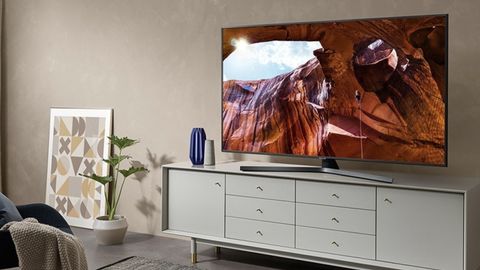TechRadar Verdict
The Samsung UE43RU7470 is the best 43-inch Samsung TV you can buy. In fact, it’s one of the best 43-inch TVs this year, full stop.
Pros
- +
Intuitive and clear OS
- +
Sophisticated HDR handling
- +
Superb upscaling from HD
- +
Rich, balanced colours
Cons
- -
Poor viewing angles
- -
Screen could be brighter
Why you can trust TechRadar
The Samsung UE43RU7470 looks impossibly good on paper. For just £399 it offers 4K resolution, HDR10+ support and a very decent dose of what goes into some of Samsung’s higher-end models. What’s more, it’s all bundled into an average household-friendly 43-inch size. If you’re looking for one of the best 43-in panels that Samsung makes in 2019, then this is it – at least on paper.
The Samsung UE43RU7470 is exclusive to Currys in the UK but the differences between it, the Samsung UE43RU7410 and the Samsung UE437400 should theoretically be largely cosmetic. While we can’t guarantee that these sets perform identically, you can realistically hope for a similar level of picture quality in all three.
Don’t expect these 7-series TVs to give you anything like QLED-type image quality, though – but with direct-lit LED panels and “hundreds of small zones” for local dimming, we’ve every right to hope for something impressive for the money.
- Check out the best 40-inch TVs available today
Price and availability
The Samsung UE43RU7470 comes in 43-inch, 50-inch, 55-inch and 65-inch sizes – and, already with a small discount since launch, they currently retail at £399, £499, £599 and £749 respectively at Currys in the UK. The Samsung UE43RU7400 has the same panel options but can be found across more stores in the UK at the same prices. The UE43RU7410 comes in just 43in and 50in sizes for £429 and £450.
None of these are models that exist in the US or Australia. The closest equivalents in those territories are the lower specced RU7100 TVs which are also part of the Samsung 2019 7-series 4K TVs.

Design
The Samsung UE43RU7470 is not the best looking TV on the block. It’s perfectly normal for a direct-lit LED TV at this level to have a 6cm profile but, seen front-on, one can’t help but notice the unfashionably broad 1.5cm bezel and the carbuncle of a boomerang stand.
The stand looks particularly silly in the smaller screen sizes, given it’s almost as wide as the display itself. It’s also quite impractical because of the way it sits so far in front of the screen. You might find it won’t go as nicely into an alcove as you hoped but it’s well worth considering wall-mounting on an extendable bracket if that’s the case.
Around the back, you’ll find some cable tidying stripes where you can trail your wires. They’re a good addition considering that this set does not benefit from the brilliant Samsung One Connect junction box. Instead, you’ll find 3x HDMI 2.0 and 2x USB 2.0 sockets waiting for you on the rear of the panel alongside the regulars like an optical audio-out connection and an Ethernet port. If you want to use headphones, then Bluetooth is your best bet.
In terms of pure measurements, the set is 56.3 x 97.0 x 5.8 cm without the stand and weighs 9.5kg. With the stand, you’re looking at 64.8 x 97.0 x 34.4 cm and 12.1kg. It’s Wi-Fi enabled and comes with Samsung’s handy little premium One Remote as well as the standard issue controller.
Design TL;DR The Samsung UE43RU7470 is a bit dated in looks and the stand is a little awkward. Fortunately, the connectivity options are good and the premium, metal One Remote controller is superb.

Smart TV (Tizen)
We’ve not come across a better smart TV platform and user-interface in 2019 than what you find on Samsung TVs. Tizen is clear, intuitive, highly responsive no matter which controller you use, and has all the major apps covered. The same cannot be said of any other TV OS at the time of writing.
Hitting the home key on either remote will bring up a quick menu that’s actually useful. It offers shortcuts to a few of the more important picture and sound modes and allows you to easily switch sources – while also being able to auto-detect and name those sources by type. There’s direct access to your favourite apps in the quick menu which you can edit as you see fit too.
Head to the far end of the quick menu and you’ll find your gateway into the full settings of the TV. You might be expecting a whole flow chart of confusion but Samsung has done an excellent job of keeping even the areas under the expert tabs pretty minimal and straightforward. There are one or two modes with names that not everyone is going to understand, but there’s still all the white balancing, colour space and gamma options if you really want to delve into them.
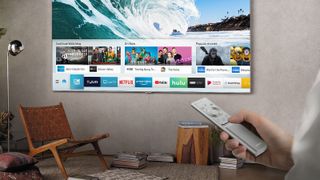
As for apps, you’re looking at all the catch-up services: Netflix, Amazon Prime Video, Rakuten, Now TV, BT Sports, BT TV, Google Play Movies & TV, YouTube, Spotify, Tidal, Deezer, Twitch, Plex, VLC and many more. It’s like someone at Samsung has decided to make it their missions to leave no app behind. Recent proof of that is that Samsung has also added the Apple TV app to its 2019 TVs to give access to even more 4K TV and film content from the iTunes Store.
The Tizen experience is made all the better with the excellent One Remote and Bixby voice control. The One Remote manages to condense all the volume, channel and navigation controls into a dinky and solid feeling format. It also works as a gesture remote for the on-screen cursor. If you press the microphone button in the corner, then you can also speak into it for Bixby to understand, and through Bixby you can search for all kinds of content, switch sources and channels and more.
The Tizen OS also allows you to connect your UE43RU7470 to your other Alexa, Google Assistant, and SmartThings-enabled devices. That way you can voice control your TV through those devices and tie your TV’s functionality into other smart home systems.
It’s also worth noting that this set is Freesat HD-compatible, in case you’d like to access programming through a satellite dish instead of a standard aerial connection.
Smart TV TL;DR The Tizen OS is a winner from top to bottom. With a full suite of apps and excellent usability, it really doesn’t get any better at the moment. Samsung’s One Remote is just the icing on the cake.
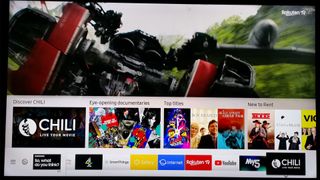
HD/SDR Performance
The Samsung UE43RU7470 gives you excellent picture quality straight out of the box. There’s very little tinkering you need to do to get the best from it. Watching Ant-Man in SDR at 1080p, we’re blown away with the level of detail we get from the close-up shots of the actors.
You get almost every worry line and wrinkle of Michael Douglas’s retired Dr Pym, thanks to the very able Samsung UHD processor working away at making up 75 per cent of every frame to turn the Full HD image into a 4K approximation. Even in scenes of high movement, there’s very little smearing and that’s no mean feat.
For both SDR and HDR source material, we used a minimal amount of Samsung’s motion processing technology. It’s not as artful as what Sony can do with its sets and, while a light touch can remove the worst of the judder, if you take the processing levels up beyond two or three notches, image quality will start to suffer.
Colour-wise, Samsung’s Dynamic Crystal Colour technology does a very decent job at 1080p too. It’s apparently able to produce over 1 billion colours. We didn’t stop to count but there was a good level of richness and depth to the brown of Pym’s suit and the red of his daughter’s lipstick. We weren’t quite convinced that these colours were as the filmmaker intended, but it’s harder to get that right in SDR.
Even down at SD resolution, this TV isn’t too shaky. Of course, true skin detail all but disappeared in close-ups when we watched The Wrestler on DVD. Thankfully, instead of becoming blotchy or looking too digitised, the UHD processor tends to smooth it out like a good layer of foundation make-up. The end result is a very watchable experience.
HD/SDR Performance TL;DR Terrific upscaling abilities makes for a superb and detailed HD watch and a very acceptable SD experience too.

4K/HDR Performance
The Samsung UE43RU7470 is not very bright. That's our only disappointment with a set at this price. Peak brightness is something a manufacturer will often boost to give a budget TV as much punch as possible, but that’s not something Samsung has done. Instead the company has made a far harder play of actually aiming for a quality picture.
While it’s not blessed with nits, all those dimming zones in the direct-lit LED panel come in incredibly useful for creating a picture with real subtlety and nuance. Watching Life of Pi in 4K HDR is a great example of how well this TV can perform. The incredible and often heavily pushed colour palette for this film is handled with great ease by this TV’s Dynamic Crystal Colour technology.
Whether it’s the vivid colours of the animals or the hues required for the Indian Ocean and stormy skies, the UE43RU7470 renders the variety of tones giving everything a textured and believable feel.
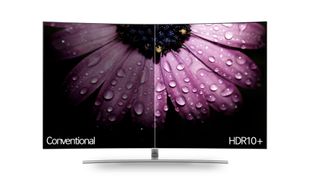
Despite Samsung’s blanket ban on Dolby Vision for the time being, HDR10 / HDR10+ are still enough for this set to get the best use of its relatively narrow dynamic range from frame to frame. Between this careful contrast and LED dimming control, it’s quite brilliant at shading given the price of the set. The end result is a very good 4K HDR picture with a wonderful sense of depth. Clouds and other backgrounds look remarkably solid and characters in the foreground look real and three-dimensional.
Black levels are, of course, not up to the standards of the much more expensive Samsung QLED range and certainly way off anything you’ll get with OLED technology. All the same the details in the dark areas of the picture are very impressive. There’s nothing lost in the night as we watch Pi Patel’s ship sink into the ocean as the rain falls and the lighting flashes.
The only issue you’ll find with the picture quality is that the viewing angles aren’t brilliant. It doesn’t need you to sit far off axis for the colours to fade and the detail with it.
4K/HDR Performance TL;DR Superb HDR and 4K handling with brilliant detail and contrast control; however, the viewing angles aren’t great and brightness is lacking.
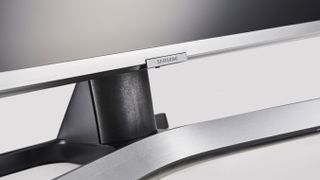
Sound
This is a budget, flat-screen TV, so don’t go expecting too much from the 2x 10W speakers around the back of the Samsung UE43RU7470 panel.
Unsurprisingly, there’s little weight to the sound. It’s not rich at any point and there’s little detail to hang onto but you can play with a few settings to at least get the impression of something greater.
There are three major sound modes – Standard, Optimised and Ambient. Standard is the honest version of this set’s audio credentials, and it doesn’t offer much in the way of a soundstage. There’s very little audio projected much beyond the panel itself, but it’s your best bet at getting enough dynamics to appreciate the sound of rain falling and the spray on the deck of the ship in Life of Pi. At the same time, though, the waves crash against the bows without the bass to give a feeling of impact.
Ambient mode rolls off the treble for a more bottom-heavy effect – albeit at the expense of the subtler parts of the soundtrack – and pushes the sound out a little wider. It might feel more immersive and cinematic, and better for listening to music, but Optimised is probably the better way to go. Here, the TV analyzes your environment and adjusts its equaliser for what it considers to be the right settings for your room. If you’re not happy with what it comes up with, then go with Standard mode.
4K/HDR Performance TL;DR Nothing to write home about here, but there rarely is at this price point. If you want good sound, go and buy a soundbar.

Other panels to consider
You’ll be very, very hard pushed to find a TV as good as this one for the same kind of money. The £249 Hisense H43B7100UK is a fair bit cheaper and offers you a lot less as well. Other than that, you could try the Panasonic TX-40GX800 but it’s a lot more at £599 and the picture quality is not as good.
Doubtless, the Panasonic is a prettier object to look at. Its stand is more practical and it’s an edge-lit TV, so it’s also a lot more slender. But the TX-40GX800, although punchy, suffers from some typical edge-lit LED problems. The backlighting is a bit patchy and the close control of the picture is much less subtle. It also doesn’t have such a good OS, we recommend sticking with the Samsung UE43RU7470.
Verdict
The Samsung UE43RU7470 is just a great TV. We could whinge about viewing angles and, sure, it could be a bit brighter – but this is a picture which has absolutely no business being sold for less than £500. It handles HDR and SDR source material with a subtle brilliance and makes short work of detail whether at 4K or upscaled from 1080p.
Complete with every app under the sun, the only reason not to buy this TV is if you’ve got a lot more money to spend and space for a larger panel.
- Best Samsung TV: top choices from the world's biggest TV maker
- Here's every 2019 Samsung TV in this year's range

Dan is How to Watch Editor at Future. His job is to make sure our readers (and our staff) know how to watch their favourite sports and entertainment online and on TV wherever they go. Dan has worked in tech journalism for over a decade, writing for Tech Digest, Pocket-lint, MSN Tech, Wareable and What Hi-Fi? as well as freelancing for T3, Metro and the Independent. Dan has a keen interest in playing and watching football. He has also written about it for the Observer and FourFourTwo and ghost authored John Toshack's autobiography, Toshack's Way.
